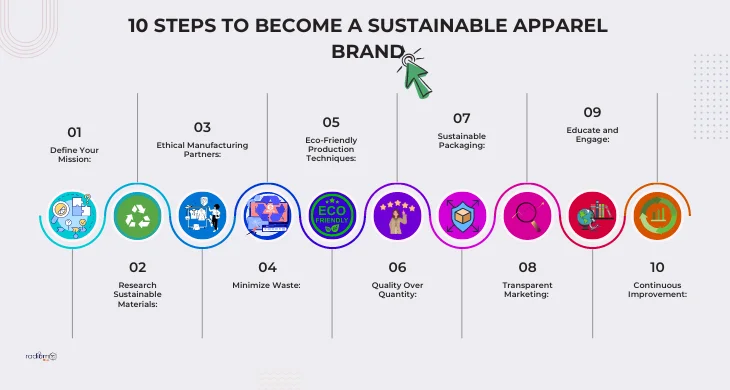In an era where conscious consumerism and environmental awareness are at the forefront of global conversations, the fashion industry is undergoing a transformative shift. The desire for sustainable, ethically produced clothing has given rise to a new generation of apparel brands that prioritize both style and responsibility. If you’re aspiring to embark on this meaningful journey of creating a sustainable apparel brand, you’re taking a step towards shaping a greener and more conscious fashion landscape.
Creating a sustainable apparel brand requires careful planning and dedication to ethical practices. Follow these 10 steps to pave the way for your brand to thrive in the world of eco-conscious fashion:
1. Define Your Mission:
BECOME A SUSTAINABLE APPAREL BRAND” is a succinct call to action that encapsulates the fundamental step of establishing a clear and purpose-driven mission for your endeavor to transform into a sustainable apparel brand,defining your mission involves outlining your brand’s commitment to adopting eco-conscious practices, ethically sourced materials, responsible manufacturing, and reducing your environmental footprint. This mission serves as the foundation upon which you’ll build your brand’s identity, values, and strategies, setting the course for your journey toward becoming a beacon of sustainability in the fashion industry.
2.Research Sustainable Materials:
BECOME A SUSTAINABLE APPAREL BRAND encapsulates the pivotal step of investigating and selecting eco-friendly materials as part of your journey to establish a sustainable apparel brand,you’ll delve into sourcing materials that align with your brand’s commitment to sustainability. This involves exploring options like organic cotton, recycled fibers, hemp, bamboo, and other innovative textiles with a reduced environmental impact. By researching and adopting sustainable materials, you’re taking a critical stride towards creating environmentally conscious and responsible fashion products that contribute to the larger goal of becoming a sustainable apparel brand.
3. Ethical Manufacturing Partners:
BECOME A SUSTAINABLE APPAREL BRAND highlights the importance of forging partnerships with manufacturers who share your commitment to ethical practices as you work towards establishing a sustainable apparel brand.This step involves identifying and collaborating with manufacturing partners that prioritize fair labor practices, safe working conditions, and environmentally conscious production methods. By aligning your brand with such partners, you ensure that the entire lifecycle of your products adheres to ethical standards, from material sourcing to manufacturing. This approach reflects your dedication to creating a positive impact on both people and the planet, which is integral to becoming a reputable and responsible sustainable apparel brand.
4. Minimize Waste:
BECOME A SUSTAINABLE APPAREL BRAND underscores the significance of reducing waste as a core aspect of your journey toward establishing a sustainable apparel brand.
In this phase, you’ll implement strategies to minimize waste throughout your production process. This includes adopting zero-waste design principles, optimizing pattern layouts to maximize fabric utilization, and exploring techniques like upcycling and recycling. By minimizing waste, you demonstrate your commitment to environmental responsibility, resource conservation, and a circular approach to fashion. This step not only aligns with sustainable practices but also positions your brand as a conscientious contributor to a greener future in the fashion industry.
5. Eco-Friendly Production Techniques:
BECOME A SUSTAINABLE APPAREL BRAND emphasizes the implementation of environmentally friendly production methods as a crucial step in your journey toward becoming a sustainable apparel brand.This stage involves adopting production techniques that have a reduced impact on the environment. This could include using water-efficient dyeing processes, energy-saving technologies, and minimizing the use of harmful chemicals. By prioritizing eco-friendly production, you demonstrate your brand’s commitment to minimizing carbon emissions, conserving resources, and creating products that resonate with conscious consumers seeking ethically produced fashion items. This step not only aligns with sustainability goals but also positions your brand as a responsible contributor to the fashion industry’s positive transformation.
6. Quality Over Quantity:
BECOME A SUSTAINABLE APPAREL BRAND emphasizes the importance of prioritizing high-quality products over mass production in your journey towards establishing a sustainable apparel brand.In this phase, you’ll shift your focus from churning out large quantities of clothing to creating fewer, but well-crafted, durable, and timeless pieces. By doing so, you promote a sustainable approach that encourages customers to invest in items that last longer, reducing the demand for fast fashion and its associated environmental impact. This commitment to quality aligns with your brand’s sustainability mission and resonates with consumers seeking value, style, and ethical consumption. By prioritizing quality over quantity, you contribute to a more responsible and mindful approach to fashion consumption.
7. Sustainable Packaging:
BECOME A SUSTAINABLE APPAREL BRAND highlights the significance of adopting eco-friendly packaging practices as a crucial step in your journey to becoming a sustainable apparel brand.In this stage, you’ll focus on selecting packaging materials that align with your brand’s commitment to sustainability. Opt for biodegradable, compostable, or recycled packaging options to minimize your brand’s environmental footprint. Sustainable packaging not only reflects your dedication to responsible business practices but also extends your brand’s ethos of caring for the planet beyond the products themselves. By making thoughtful choices in packaging, you demonstrate your brand’s holistic approach to sustainability and contribute to reducing waste in the fashion industry.
8. Transparent Marketing:
BECOME A SUSTAINABLE APPAREL BRAND emphasizes the importance of transparently communicating your sustainability efforts as a core component of your journey to establish a sustainable apparel brand.During this phase, you’ll focus on sharing your brand’s sustainability initiatives, ethical practices, and the positive impact you’re making on social and environmental fronts. Transparent marketing involves open communication about your materials, sourcing methods, production processes, and partnerships. By being honest and forthcoming with your audience, you build trust and credibility, attracting conscious consumers who align with your brand values. Transparent marketing not only showcases your brand’s authenticity but also educates and empowers consumers to make informed choices in favor of sustainable fashion.
9. Educate and Engage:
BECOME A SUSTAINABLE APPAREL BRAND underscores the significance of educating and engaging consumers as a pivotal step in your journey towards establishing a sustainable apparel brand.During this stage, you’ll focus on raising awareness about sustainable fashion and its positive impacts on individuals and the environment. Educate your audience through various channels, such as social media, blogs, and events, about the importance of conscious consumption, ethical choices, and the benefits of supporting sustainable brands. Engage consumers in meaningful conversations about responsible fashion practices and empower them to make informed purchasing decisions. By becoming a source of knowledge and inspiration, you not only build a community of conscious consumers but also contribute to the larger movement for a more sustainable fashion industry.
10. Continuous Improvement:
BECOME A SUSTAINABLE APPAREL BRAND highlights the ongoing commitment to growth, innovation, and refinement as an essential step in your journey to becoming a sustainable apparel brand.In this final phase, you’ll recognize that sustainability is an evolving process. Embrace the mindset of continuous improvement by regularly evaluating your practices, seeking innovative solutions, and staying informed about the latest advancements in sustainable fashion. Adapt to changing industry standards, incorporate feedback from customers and stakeholders, and challenge yourself to push the boundaries of eco-consciousness. By fostering a culture of continuous improvement, you not only demonstrate your brand’s dedication to sustainability but also inspire positive change within the fashion industry as a whole.
FAQS:
Q1: What does it mean to be a sustainable apparel brand?
A1: A sustainable apparel brand prioritizes ethical practices, eco-friendly materials, and responsible production to minimize its impact on the environment and promote positive social contributions.
Q2: Why is sustainability important in the fashion industry?
A2: The fashion industry has significant environmental and social impacts. Embracing sustainability helps reduce pollution, waste, and exploitation while fostering a more ethical and eco-conscious approach to fashion.
Q3: How do I begin the process of becoming a sustainable apparel brand?
A3: Start by defining your brand’s mission and values, then research sustainable materials and ethical manufacturing partners. Follow through with eco-friendly production techniques and practices that prioritize quality, transparency, and continuous improvement.
Q4: What are some examples of sustainable materials for clothing?
A4: Sustainable materials include organic cotton, recycled fibers, Tencel, hemp, and bamboo. These options have a lower environmental impact compared to conventional fabrics.
Q5: How can I find ethical manufacturing partners for my brand? \A5: Look for manufacturers that prioritize fair labor practices, safe working conditions, and environmentally friendly processes. Research and vet potential partners thoroughly.
Q6: How can I minimize waste in my production process?
A6: Adopt zero-waste design principles, optimize fabric usage, and explore upcycling and recycling techniques to reduce waste during production.
Q7: What are some eco-friendly production techniques I can implement?
A7: Incorporate water-efficient dyeing methods, energy-saving technologies, and chemical-free processes to minimize your brand’s carbon footprint.
Conclusion :
Embarking on the journey to become a sustainable apparel brand is a transformative endeavor that aligns both creativity and responsibility. The 10 steps outlined in this guide illuminate a path that not only leads to successful business growth but also contributes to a more conscientious and ethical fashion industry.
As you define your mission, research sustainable materials, forge ethical partnerships, minimize waste, adopt eco-friendly practices, prioritize quality, embrace sustainable packaging, practice transparent marketing, educate and engage your audience, and commit to continuous improvement, you’re weaving a tapestry of sustainability that extends far beyond your garments.




